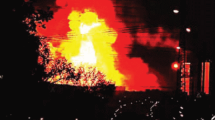Abstract
The measurement of residual stress by the Hole-drilling method consists basically of drilling a blind-hole in the material under study. That relieves and redistributes the stresses around this hole promoting a surface deformation which adapts to a new equilibrium condition. This deformation provides, indirectly, information on the stress state to which the part or component is submitted. However, when not properly controlled, the drilling process can introduce additional stresses in the hole walls. Thus, the true value for the residual stress may be masked. Therefore, in this study, the hole-drilling process was investigated. More specifically, the influence of the feed and rotational speed on the hole walls and bottoms was evaluated. In addition, the hole geometry produced by the end-mill was investigated. Blind-holes were produced in the alloys A36 steel, AISI 304 L stainless steel and AA6061 aluminum, using an air-turbine, which provided an average rotational speed of 220,000 rpm. Only two feed rates were applied. The geometric measurement of both the tools and the holes produced showed that the hole geometry deviated from that recommended in ASTM E837-13a. Both decrements and increments in the hardness value for the hole walls and bottoms were observed, indicating that the process may have reached very high temperatures.











Similar content being viewed by others
References
Mathar J (1934) Determination of initial stresses by measuring the deformation around drilled holes. Trans ASME 56(2):249–254
ASTM Standard E837 13a (2014) Standard test method for determining residual stresses by the hole-drilling strain-gage method, ASTM International, West Conshohocken, PA, 2014, DOI: 10.1520/E0837-13A.
Flaman M (1982) Brief investigation of induced drilling stresses in the center-hole method of residual-stress measurement. Exp Mech 22(1):26–30
Flaman M, Herring J (1985) Comparison of four hole-producing techniques for the center-hole residual-stress measurement method. Exp Mech 9(8):30–32
Flaman M, Herring J (1986) Ultra-high speed center hole technique for difficult machining materials. Exp Tech 10(1):34–35
Steinzig M, Upshaw D, Rasty J (2014) Influence of drilling parameters on the accuracy of hole-drilling residual stress measurements. Exp Mech 54(9):1537–1543
Nelson D, Fuchs E, Makino A, Williams D (1994) Residual-stress determination by single-axis holographic interferometry and hole drilling – Part II: experiments. Exp Mech 34(1):79–88
Viotti MR, Sutério R, Albertazzi AG Jr, Kaufmann GH (2004) Residual stress measurement using a radial in-plane speckle interferometer and laser annealing: preliminary results. Opt Lasers Eng 42(1):71–84
Viotti MR, Albertazzi AG Jr (2009) Industrial inspections by speckle interferometry: general requirements and a case study. SPIE Proc 7389, 15p
Viotti MR, Kapp W, Albertazzi AG Jr (2009) Achromatic digital speckle pattern interferometer with constant radial in-plane sensitivity by using a diffractive optical element. Opt Lasers Eng 48(12):2275–2281
Viotti MR, Albertazzi AG Jr, Kapp W (2008) Experimental comparison between a portable DSPI device with diffractive optical element and a hole drilling strain gage combined system. Opt Lasers Eng 46(11):835–841
ASTM Standard E92-82 (2003) Standard test method for vickers hardness of metallic materials. West Conshohocken, 2003. 9 p.
König W, Klocke F (2008) Fertigungsverfahren: Drehen, Fräsen, Bohren, 8th edn. Springer, Berlin, 547 p
Trent EM, Wright PK (2000) Metal cutting, 4th edn. Butterworth-Heinemann, Woburn, 464 p
Astakhov VP (2006) Tribology of metal cutting, 1st edn. Elsevier, Great Britain, 426 p
Acknowledgments
Authors would like to thank Petrobras and CNPq for financial support for the development of this research. We also thank the Institut für Werkzeugmaschinen und Fertitug (IWF)/ETH Zurich for support with the Alicona Microscope.
Author information
Authors and Affiliations
Corresponding author
Rights and permissions
About this article
Cite this article
Blödorn, R., Viotti, M.R., Schroeter, R.B. et al. Analysis of Blind-Holes Applied in the Hole-Drilling Method for Residual Stress Measurements. Exp Mech 55, 1745–1756 (2015). https://doi.org/10.1007/s11340-015-0082-5
Received:
Accepted:
Published:
Issue Date:
DOI: https://doi.org/10.1007/s11340-015-0082-5







